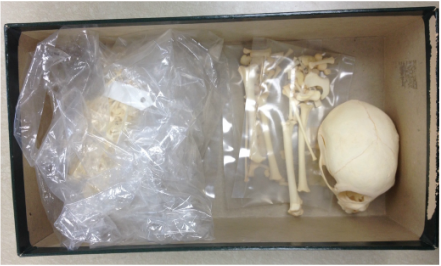Collections

Fossil cast collection
The UC Davis Anthropology Department has a collection of approx. 800 fossil casts, covering primate and human evolution. This collection is mainly used for teaching lower and upper division Anthropology classes.
Lithics collection
Coming soon.
Primate skeletal collection
The UC Davis Anthropology Department houses a primate skeletal collection of approx. 600 specimens of known aged, non-human primates from 30 different species. The primate collection was created in the 1960s and 70s by the California National Primate Research Center (at UC Davis), and donated to Anthropology soon after. To access the collection, please contact Tim Weaver.

Virtual paleoanthropology tools
Two Artec Spider II handheld scanners (https://www.artec3d.com/portable-3d-scanners/artec-spider) and one CreatBot F430 NX 3D Printer (https://www.creatbot.com/en/creatbot-f430nx.html).
Zooarchaeology Lab
The UC Davis Anthropology Department Zooarchaeology Lab houses a comparative collection of over 1800 animal skeletons from more than 530 species. The collection is used for both teaching and research and lab space is available for studying the materials.
Wildlife, Fish, and Conservation Biology Museum
The Wildlife, Fish, and Conservation Biology Museum is a major repository of birds, mammal, and fish remains, housing over 40,000 specimens. These collections provide an invaluable resource for zooarchaeological research. Andrew Engilis, Jr. is the curator of these collections.
Downloads
To download STL and PLY files with the triangular mesh of the Tabun reconstruction presented by Weaver and Hublin (2009. Proceedings of the National Academy of Sciences of the USA) and an ASCII (.txt) file with the locations of the landmarks Weaver and Hublin analyzed (including the estimated landmarks), please click here.
To download the program for analyzing mortality profiles on a triangular graph presented by Weaver, Boyko, and Steele (2011. Journal of Archaeological Science), please click here.
To download specimens from the Virtual Comparative collection described by Niven L, TE Steele, H Finke, T Gernat and J-J Hublin (2009. Virtual skeletons: using a structured light scanner to create a 3D faunal comparative collection. Journal of Archaeological Science 36:2018-2023), please click here, and scroll down to the bottom of that page.
Contact Tim Weaver or Hélène Coqueugniot for the Excel spreadsheets or Matlab computer programs for age estimation from infracranial sequences of maturation presented by Coqueugniot, Weaver, and Hoüet (2010. American Journal of Physical Anthropology). Alternatively, David Navega and João Coelho have implemented the method in a web application available here.
